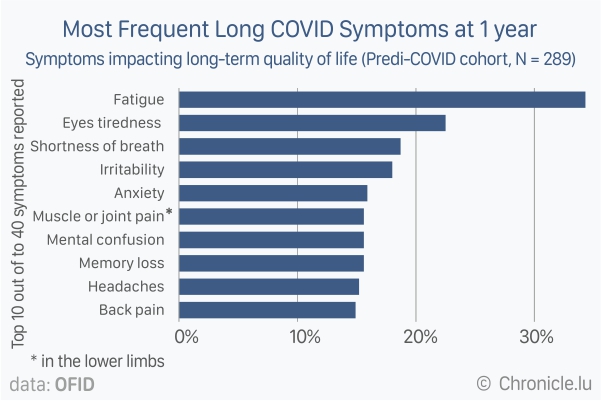
An all-Luxembourg study finds that ‘Long COVID’, generally referred to onset of persistent symptoms after the initial acute COVID-19 infection, is not just a single disease but can take a variety of forms with different symptoms and potential treatments.
The study was published on 5 August 2022 in Open Forum Infectious Diseases (OFID), a peer-reviewed open access journal dedicated to the intersection of biomedical science and clinical practice, under the full title “Long COVID Symptomatology After 12 Months and Its Impact on Quality of Life According to Initial Coronavirus Disease 2019 Disease Severity”.
A consortium of Luxembourgish research institutions studying the national population have been looking to identify factors that may contribute to variations in severity of COVID-19 and its associated symptoms. In their most recent study the teams were able to show that individuals who experienced moderate to severe cases of the acute COVID-19 infection were more likely to experience increased frequencies and burden of symptoms after twelve months, with a notable impact on quality of life. Furthermore, the researchers were able to identify various sub-categories of Long COVID for the first time, showing that it is not a single disease as previously thought.
The “CoVaLux” (COVID-19, Vaccination & long-term health consequences of COVID-19 in Luxembourg) study is coordinated by Research Luxembourg and a consortium of Luxembourgish research institutions, including the Luxembourg Institute of Health (LIH). Overall, this unique project is providing important results that are helping to improve the understanding and long-term impacts of COVID-19, while also leading to improvements in patient care.
In its first published work led by Dr Guy Fagherazzi, Director of the Department of Precision Health at LIH, the consortium has investigated the association between the severity of the initial COVID-19 infection and the frequency and burden of symptoms in patients twelve months later. The hope of researchers was that this could shed more light on the nature of Long COVID, filling in crucial blanks that could ultimately help to predict outcomes and uncover more about the disease.
“An increasing number of studies report long-term health consequences across the spectrum of patients who have had COVID-19. As such, the identification of predictive markers and risk factors of the long-term sequelae of COVID-19 has been defined as a research priority. Our hypothesis is that Long COVID symptomatology may differ according to the initial COVID-19 disease severity and that symptoms can cluster and define sub-types of Long COVID,” explained Dr Fagherazzi.
Among the 289 adult participants who fully completed the twelve-month questionnaire, almost 60% reported at least one symptom with an average of six symptoms. These could range from the more commonly known fatigue and shortness of breath, to less well-known problems such as memory loss and gastrointestinal problems. When one considers that over 580 million cases of COVID-19 have been diagnosed around the world so far, this indicates that a significant number of people could be experiencing Long COVID in some form.
Regarding the effect of the initial disease severity, the volunteers who had experienced an initial moderate or severe COVID-19 infection were found to be more than twice as likely to experience Long COVID symptoms after one year, than those who had been mild or asymptomatic at the beginning. Furthermore, moderate to severe sufferers had an average of 6 more symptoms than those who had been initially asymptomatic. These results indicate that Long COVID and its severity have strong links to the severity of the initial infection, where a worse case of COVID-19 could significantly increase your chances of having more symptoms that last for longer.
A further striking outcome of the study was the researchers’ ability to see patterns in the symptoms of participants, which suggests that Long COVID is likely made up of multiple sub-categories rather than a single disease. By looking at how symptoms tended to cluster in individuals, it was possible to get some idea of how these sub-categories present themselves. For example, loss of taste and smell appears to characterise one type of Long COVID, while another could be better described by gastrointestinal symptoms including nausea, diarrhoea, stomach burns and other abdominal pain. This information could be extremely useful as researchers seek to better define the disease and hunt for effective therapies.
“Our study provides an extensive description of symptoms present twelve months after COVID-19 infection and highlights a significant burden for people living with Long COVID. With this work, we are helping to describe Long COVID and confirm that it is multisystemic and presents different clusters of symptoms. These results will ultimately help to better identify Long COVID in clinical settings and contribute to the definition of precision health strategies to improve the care of people with Long COVID,” summarised the study’s lead author Aurélie Fischer, Scientific Coordinator in the LIH’s Deep Digital Phenotyping Research Unit.








